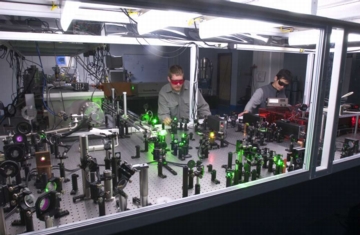Home > Press > Colorado State scientists dramatically improve soft x-ray lasers with discovery
 |
Abstract:
Colorado State University scientists have found a way to dramatically improve the quality of laser light at extremely short wavelengths, according to a paper that was published Sunday online by Nature Photonics.
Colorado State scientists dramatically improve soft x-ray lasers with discovery
FORT COLLINS, CO | Posted on January 22nd, 2008The groundbreaking discovery covers very short wavelengths of light near 13 nanometers that are valuable particularly for the semiconductor manufacturing industry, which aims to develop the next generation of faster computer chips using that type of light by 2010 or 2011, said CSU University Distinguished Professor Jorge Rocca, senior author of the research. Rocca collaborated on the Nature Photonics paper with CSU colleagues Yong Wang, Brad Luther, Francesco Pedaci, Mark Berrill, Eduardo Granados and David Alessi.
"The potential applications are many - ultrahigh resolution microscopy, patterning to make nanodevices, and semiconductor industry measurements," Rocca said. "There are many other possibilities that in the future will also include biology."
The technology involves the generation of short wavelength light in the extreme ultraviolet or soft X-ray range of the electromagnetic spectrum with wavelengths about 50 times shorter than visible light. A nanometer is billionths of a meter. A human hair is about 60,000 nanometers. These lasers can be used to "see" tiny features, create extremely small patterns and manipulate materials in ways that visible light can't.
The research reported in the Nature Photonics paper focused on making the light of lasers operating at 18.9 and 13.9 nanometers more "coherent" - a property that distinguishes laser light from light generated by other sources. Rocca's team generated a little seed of coherent X-ray light, converted the frequency of a visible laser beam to soft X-ray light and obtained a very coherent light at a low intensity. That seed was injected through a plasma amplifier and grew to produce a very high intensity beam of soft x-ray light with extraordinarily high coherence.
"Coherent soft x-ray light can be used to measure the properties of materials and directly write patterns with nano-scale dimension," Rocca said. "It can be used to look for extremely small defects in the masks that will be used to print the future generations of semiconductor chips."
The work is part of the research conducted at the National Science Foundation's Center for Extreme Ultraviolet Science and Technology - a partnership between Colorado State University in Fort Collins, the University of Colorado-Boulder and the University of California Berkeley - that combines the expertise of researchers who are among the world leaders in developing compact extreme ultraviolet coherent light sources, optics and optical systems for nanoscience, nanotechnology and other applications.
The center also has significant industry and national laboratory involvement. The largest computer chip manufacturers - Intel, Advanced Micro Devices Inc, IBM and Samsung - are industrial members of the EUV ERC, joining a set of industries that include small- and medium-sized companies.
####
About Colorado State University
Colorado State University is one of our nation's leading research universities with world-class research in infectious disease, atmospheric science, clean energy technologies, and environmental science. It was founded in 1870 as the Colorado Agricultural College, six years before the Colorado Territory became a state.
Last year, CSU awarded degrees to more than 5,000 graduates, and this year, it attracted nearly $300 million in research funding. Colorado State is a land-grant institution and a Carnegie Doctoral/Research University-Extensive.
For more information, please click here
Contacts:
Emily Narvaes Wilmsen
(970) 491-2336
Copyright © Colorado State University
If you have a comment, please Contact us.Issuers of news releases, not 7th Wave, Inc. or Nanotechnology Now, are solely responsible for the accuracy of the content.
| Related News Press |
News and information
![]() Researchers develop molecular qubits that communicate at telecom frequencies October 3rd, 2025
Researchers develop molecular qubits that communicate at telecom frequencies October 3rd, 2025
![]() Next-generation quantum communication October 3rd, 2025
Next-generation quantum communication October 3rd, 2025
![]() "Nanoreactor" cage uses visible light for catalytic and ultra-selective cross-cycloadditions October 3rd, 2025
"Nanoreactor" cage uses visible light for catalytic and ultra-selective cross-cycloadditions October 3rd, 2025
Discoveries
![]() Researchers develop molecular qubits that communicate at telecom frequencies October 3rd, 2025
Researchers develop molecular qubits that communicate at telecom frequencies October 3rd, 2025
![]() Next-generation quantum communication October 3rd, 2025
Next-generation quantum communication October 3rd, 2025
![]() "Nanoreactor" cage uses visible light for catalytic and ultra-selective cross-cycloadditions October 3rd, 2025
"Nanoreactor" cage uses visible light for catalytic and ultra-selective cross-cycloadditions October 3rd, 2025
Announcements
![]() Rice membrane extracts lithium from brines with greater speed, less waste October 3rd, 2025
Rice membrane extracts lithium from brines with greater speed, less waste October 3rd, 2025
![]() Researchers develop molecular qubits that communicate at telecom frequencies October 3rd, 2025
Researchers develop molecular qubits that communicate at telecom frequencies October 3rd, 2025
![]() Next-generation quantum communication October 3rd, 2025
Next-generation quantum communication October 3rd, 2025
![]() "Nanoreactor" cage uses visible light for catalytic and ultra-selective cross-cycloadditions October 3rd, 2025
"Nanoreactor" cage uses visible light for catalytic and ultra-selective cross-cycloadditions October 3rd, 2025
Photonics/Optics/Lasers
![]() ICFO researchers overcome long-standing bottleneck in single photon detection with twisted 2D materials August 8th, 2025
ICFO researchers overcome long-standing bottleneck in single photon detection with twisted 2D materials August 8th, 2025
![]() Institute for Nanoscience hosts annual proposal planning meeting May 16th, 2025
Institute for Nanoscience hosts annual proposal planning meeting May 16th, 2025
|
|
||
|
|
||
| The latest news from around the world, FREE | ||
|
|
||
|
|
||
| Premium Products | ||
|
|
||
|
Only the news you want to read!
Learn More |
||
|
|
||
|
Full-service, expert consulting
Learn More |
||
|
|
||








